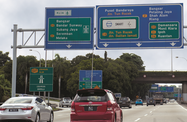The forthcoming entry of Malaysia’s largest airline into the oneworld alliance, a group of the world’s major airlines, plus efforts among airlines to boost connectivity in Asia and invest in capacity to support long-term growth, are set to increase flight frequency and services.
Duncan Bureau, the senior vice-president of global sales and distribution at Malaysia Airlines (MAS), the country’s flag carrier, said recently that the airline is making progress toward its planned membership in the oneworld airline alliance, which is expected to be completed in early 2013. MAS is forming bilateral agreements on code shares with a number of oneworld carriers, most recently Cathay Pacific and Royal Jordanian.
To prepare, the airline has made a number of recent investments in newer, more fuel-efficient aircraft, which is expected to reduce its long-term costs, particularly on fuel. In August, MAS took delivery of its second Airbus A380. The new aircraft will allow MAS to increase its A380 service between Kuala Lumpur and London from the current three times a week to every day. A third A380 should be commissioned by the end of November, which will fly daily between Kuala Lumpur and Sydney. Also in August, MAS received its 75th delivery of a Boeing 737, with a “next-generation” 737-800.
The airline also aims to increase passenger loads on its routes to India by 15% in 2012, the international press reported in mid-August. MAS flies a total of 40 weekly flights to five cities in India from Kuala Lumpur. The airline is planning to increase frequencies to Mumbai (Bombay), Chennai (Madras) and Bengaluru (Bangalore) from September 1 to strengthen connectivity and provide more options for passengers on these routes.
MAS is targeting a return to profitability next year as efforts to strengthen its financial position seem to be paying off. The airline cut its losses in the second quarter of 2012 to RM348.7m ($112.44m), from RM525.8m ($169.55m) in the first quarter. It has been particularly successful in tackling fuel costs (which accounted for 37% of expenses in the period), reducing them by 18%. The airline said that foreign exchange losses of RM173m ($55.79m) contributed to its losses.
“The group's aggressive focus to consolidate our network is helping the turnaround, as already showing in the improvement in yield and lower operating expenses, specifically spending on fuel,” said Ahmad Jauhari Yahya, the CEO of MAS.
The industry is also seeing increasing expansion via MAS’s budget rival, AirAsia. The airline, headquartered in Kuala Lumpur but with subsidiaries in Indonesia and Thailand, continues to grow. In July, it announced the purchase of Indonesia’s Batavia Air for $80m, its first major acquisition and a foray into the fast-growing Indonesian market.
The same month, AirAsia X, the carrier’s long-haul division, announced that it aimed to double flights to Australia from Kuala Lumpur, as it increases its fleet of twin-aisle Airbus A330s to 25 from the current 11. This will see the airline compete with MAS on Australian routes, as well as with Singapore Airlines’ new budget line Scoot and Jetstar, the low-cost subsidiary of Australia’s Qantas.
Earlier this year, AirAsia pulled out of a share swap deal with MAS, citing the latter’s problems with management and labour unions. The deal was intended to ease the rivalry between the two carriers, and lead to a degree of route consolidation, loosening the squeeze on profitability. While the agreement fell through, some feel the groundwork for greater cooperation has now been laid.
The suspended talks notwithstanding, Malaysia’s air transport segment is on the cusp of imminent expansion as a result of MAS’s entry into oneworld and increasing flight frequencies between Kuala Lumpur and other regional capitals.

